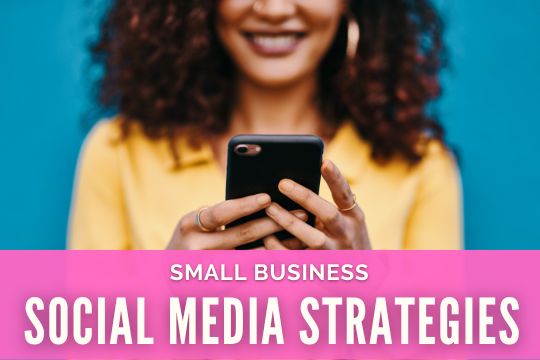
As a small business, you look at corporations with hundreds of thousands of followers and assume that it's impossible to achieve. At times, social media challenges for small business seem insurmountable. However, even the biggest businesses in the world started out small--and social media provides more marketing opportunities than ever.
A creative marketing strategy kickstarts your momentum and helps you build an audience. A hundred followers become a thousand, then several thousand. You'll build a community that enjoys interacting with you instead of passively scrolling through your posts. Use these tips to overcome challenges and develop a tighter marketing strategy.

If you're just starting out, many of these strategies are free. You can use stock photos, launch partnerships, and consider your tone and audience. As you advance, you can tackle paid promotions, hire social media managers and take advantage of marketing tools and products. Use a combination of free and paid strategies to get the most out of your budget.
You're never going to master everything. Instead of trying to reach every person with every content format, focus on a few content types that are relevant to your business. For example, instead of signing up for every social media platform, you could focus on creating graphics and videos for Instagram and Twitter. Study your demographic to see what's most relevant to your audience.
This doesn't mean you should limit yourself--if you alternate solely between memes and advertisements, you'll bore your followers. However, don't push yourself to master long-form videos, short clips, graphics, quotes, memes, articles, and how-to guides all at once. Experiment once in a while with new formats to see what works, but don't waste time on a failed venture.
As you build your audience, look for ways to expand your outreach. Don't try to reach everyone--you'll waste your time marketing toward unprofitable demographics. However, evaluate your current audience, then figure out how to reach more people in that bubble. You could also slightly expand your demographic--just keep a particular group in mind.
For example, if your Instagram followers respond well to Reels, start sharing more videos on different topics. Invite guests to your videos to educate and entertain your audience, and experiment with different filters and formats. You might even extend your reach to TikTok if you find success with short videos.

Following customers, answering questions, and replying to comments helps people connect with your business, but they're still isolated from other customers. A Facebook group offers a community where people interact with each other and talk to you directly. They'll make friends, share advice and have fun online--all because of your small business.
However, you'll need to give people a reason to join your group. They probably won't join a group that exists solely to advertise your products or makes vague mentions of a "community" without inspiring discussion. Think about your business and how it ties to your audience's lifestyle.
For example, if you sell cookware, you could start a group that invites people to discuss cooking and share recipe tips. Make sure you ask questions and post on a regular basis to stimulate discussion. You can share the occasional promotion, but focus on the community and respond to people's comments.
Everyone wants attention on social media. In fact, earning attention is partially why social media exists. Interacting with customers is one of the best social media strategies for small business because it makes them feel valued, creating positive associations with your product. They'll start to see you as a friend instead of a faceless company.
Find ways to tag customers in your posts to make them feel appreciated. Don't try to tag dozens of people in one post--people will untag themselves when they realize that it's a publicity stunt. Instead, focus on a few people who benefited your business. For example, you could post a shoutout for a few new followers or tag someone who recently bought your product.
Since tags appear in your followers' notifications, you'll get their attention directly without relying on passive scrolling. They might even share the post, bringing more followers to your business.
To make sales, you need to show customers why they need your product. If a follower sees an advertisement for your makeup line, they might be intrigued but decide that they have enough makeup already. But if you tie your makeup line to their daily life, they'll feel a sudden need for the product.
For example, you could point out that your makeup line offers neutral colors that create an Instagram-ready look. Instead of passively viewing your advertisement, your follower starts thinking about fashion trends and how much they want to be an influencer. This creates a need that they didn't have before, leading to increased sales.

While you probably know not to share your competitors' content, sharing relevant posts from other people adds context, breaks up your usual content, and creates "share-worthy" moments. A follower might not share an advertisement, but they'll share a quote or meme. Since you've attached your business's name to the post, you'll get free advertising.
This doesn't mean that you should steal content--that shows the community that they can't trust you and might get your account taken down. However, you can share the occasional meme, art piece, quote, or how-to guide that grabs your followers' attention and makes your products more relevant to their lives. Sometimes, it's as simple as retweeting a quote or sharing a photograph on your Instagram story.
Partnering with other businesses offers a cross-promotion opportunity that earns followers for both companies. While you obviously don't want to partner with your competitors, look for businesses that are different but still relevant. For example, if you own a photography business, you could partner with a graphic designer who creates posters, invitations, and artwork with their customers' photos.
Once you've partnered up, you can offer your customers discounts or sell a package that combines your services. Share the partnership on social media to advertise the promotion and show off your professionalism. When you're successful enough to work with other established businesses, you build trust with your followers.

If you haven't already, find the right tone for your business. A makeup line marketed to women in their early 20s could have a light, playful tone. Likewise, a business that sells luxury cookware might sound formal and sophisticated. This appeals to your audience because they feel like you're speaking to them directly.
Once you've figured it out, make sure your social media content matches your tone. If you sell medical supplies, memes and funny videos will confuse your audience and make them think that they stumbled on the wrong page. Build content that's professional, lighthearted, mature, or youthful depending on your demographic's needs.
You've probably heard stories about business owners who figured out a successful formula, then scrapped it to "shake things up" in the hopes that a massive shift would drive sales. Instead, they lost followers and alienated their demographic. Experimenting with different content doesn't mean abandoning a successful strategy. Instead, you'll embrace the occasional new idea without scrapping your plans.
Periodically, social media platforms offer new content types, like Twitter Blue and Instagram Reels. Try out the new technology to see if it benefits your business. You can also experiment with content that you haven't tried yet, like long-form articles. View your analytics to see if your experiment should become a permanent part of your strategy.
Email newsletters are essentially repeat advertising that costs much less than paid promotions. Once a client signs up for your newsletter, they'll get news, updates, and promotions in their inbox. Even if they don't open the emails, they'll still see your business's name, driving your business into their memory and making them more likely to choose you over a competitor.
If you don't have an email newsletter, you can still send direct messages (DMs) to followers on Instagram, Twitter, and Facebook. Introduce yourself and thank them for following you, then provide a short message about your products or services and invite them to ask questions. Just limit yourself to one brief message so new followers don't feel like you're bombarding them.
Sign Up for Our Small Business Newsletter
Now that you've learned about social media strategies for small businesses, subscribe to the EMA newsletter for timely articles to help your small business grow. You can also visit our blog for free guides, tips, and advice that help you manage your business.
Begin by setting clear goals, defining your audience, and auditing available resources. Claim profiles on the platforms your customers already use, create a simple content calendar, and start posting consistent, relevant content before worrying about paid ads or fancy tools.
Study your customers' age, interests, and habits, then research where similar audiences are most active. Match platform strengths to your content type—visual brands lean toward Instagram, video heavy brands to TikTok or YouTube, B2B firms to LinkedIn. Focus on two or three channels you can handle well.
Try a small experiment every month or when a platform releases a new feature. Test one variable at a time, watch analytics for at least two weeks, and keep the tactic only if it outperforms your usual content. This approach limits risk while still encouraging growth.
A Facebook group transforms isolated followers into a community that supports each other and your brand. Members ask questions, share successes, and see your business as the hub of their interest, increasing loyalty, word-of-mouth referrals, and organic reach without relying solely on algorithmic news-feed exposure.
Look for complementary, not competing, businesses that serve a similar audience. Approach them with a clear win-win proposal, such as bundled discounts, joint giveaways, or co-created content. Set ground rules on branding, pricing, and customer data so both parties gain exposure without cannibalizing each other's sales.